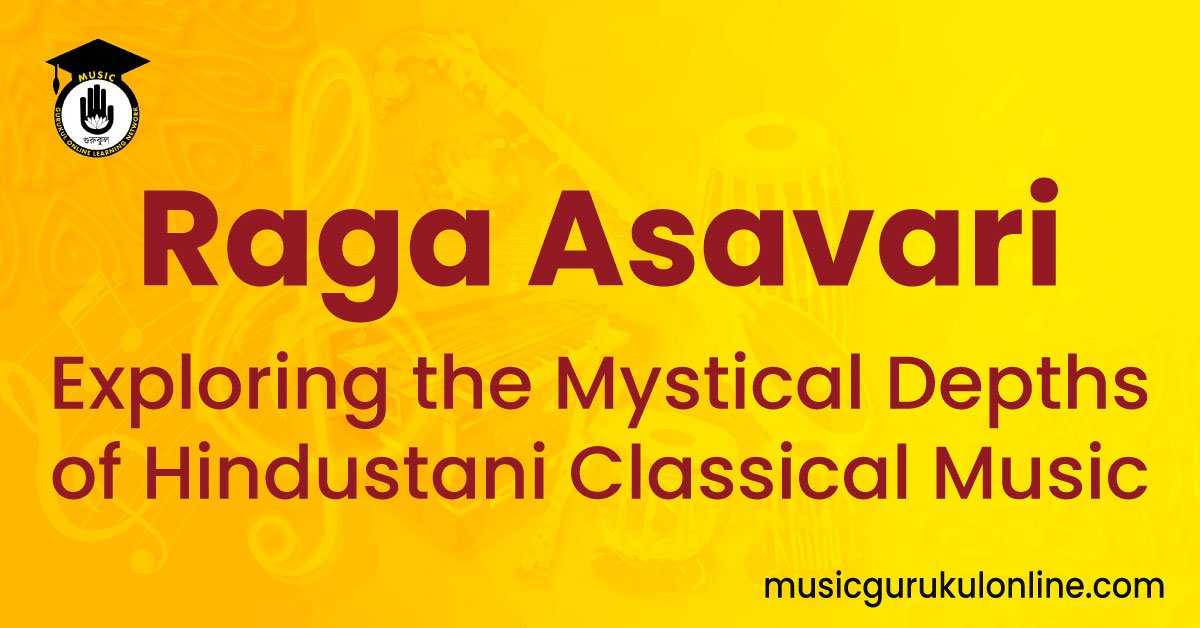In pre-Bhatkhande days this Raga Asavari used the Komal Rishab instead of Shuddh Rishab. When Bhatkhandeji created the thaat process, he changed that Asavari’s Komal Rishab to Shuddha Rishab but the name remained the same. From that time the old or real ‘Asavari’ has been called the Komal Rishabh Asavari, and the new Shuddha Rishabh Asavari is simply called ‘Asavari’.

Table of Contents
Raga Asavari
Hindustani classical music, with its rich heritage and intricate melodic structures, has captivated listeners for centuries. Among the numerous ragas that form the backbone of this musical tradition, Raga Asavari holds a special place. Known for its hauntingly beautiful and evocative melodies, Asavari has been a source of inspiration for musicians and connoisseurs alike. In this article, we delve deep into the nuances of Raga Asavari, exploring its origin, characteristics, emotional impact, and notable compositions.
Origins and Historical Significance: The origins of Raga Asavari can be traced back to ancient times, with references to this raga found in ancient Indian treatises on music such as the Natyashastra and Sangeet Ratnakar. It is believed to have evolved from the folk music traditions of North India, gradually finding its place in the classical music framework. Asavari belongs to the Asavari Thaat, which is one of the ten foundational scales in Hindustani classical music.
Characteristics and Structure:
Raga Asavari is classified under the Asavari Thaat, which gives it a distinct tonal framework. It is primarily a night raga, traditionally performed during the late evening or early night hours. Asavari’s tonal structure is characterized by the use of flat or komal (minor) Gandhar (Ga) and flat or komal Dhaivat (Dha), along with natural or shuddha (major) Rishabh (Re) and Pancham (Pa). The remaining notes, Shadja (Sa), Madhyam (Ma), and Nishad (Ni), are considered achal or stable notes in this raga.

Emotional Impact:
Raga Asavari is known for its introspective and contemplative mood. It evokes a sense of yearning, longing, and profound pathos. The use of flat Gandhar (Ga) and Dhaivat (Dha) adds a melancholic touch, while the shuddha Rishabh (Re) and Pancham (Pa) provide stability and grounding. The raga’s inherent depth and emotive power make it well-suited for expressing the somber and introspective aspects of human experience.
Melodic Exploration:
In Hindustani classical music, the melodic framework of a raga is explored through various musical elements such as arohana (ascent), avrohana (descent), pakad (defining melodic phrase), and vadi-samvadi (prominent and sub-prominent notes). In Raga Asavari, the arohana (ascending scale) follows the pattern: Sa Re Ma Pa, Ma Pa Dha Sa. The avrohana (descending scale) follows the pattern: Sa Dha Pa, Ma Pa Ga Re Sa. The vadi (prominent note) is Re, and samvadi (sub-prominent note) is Pa.

Notable Compositions and Performances:
Raga Asavari has inspired numerous compositions across different genres of Indian classical music, including dhrupad, khayal, thumri, and bhajan. Renowned composers such as Tansen, Amir Khusro, and Surdas have composed immortal melodies in this raga. Some popular compositions include “Raga Asavari Alaap” by Ustad Bade Ghulam Ali Khan, “Aeri Aali Piya Bin” by Pandit Kumar Gandharva, and “Morey Saiyan” by Ustad Amanat Ali Khan. These compositions showcase the melodic beauty and emotional depth of Asavari.
Contemporary Usage and Adaptations:
While Raga Asavari has a deep-rooted connection with classical music, it has also found its way into contemporary musical expressions. Musicians across genres have experimented with Asavari, blending it with fusion, jazz, and world music influences. This fusion of traditional and modern elements has given rise to unique compositions and collaborations that push the boundaries of musical experimentation.

Raga Asavari, with its introspective and melancholic melodies, continues to mesmerize audiences with its profound emotional impact. Its historical significance, tonal structure, and notable compositions make it an integral part of the Hindustani classical music tradition. Asavari’s ability to evoke a sense of longing and yearning showcases the power of music to tap into the depths of human emotion. Whether performed in its pure classical form or as part of contemporary adaptations, Raga Asavari remains a testament to the timeless beauty and universal appeal of Hindustani classical music.
See more:
